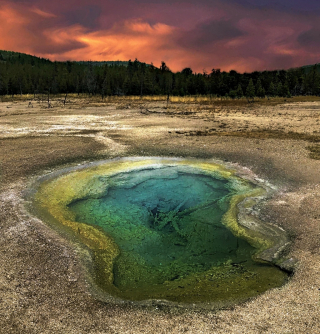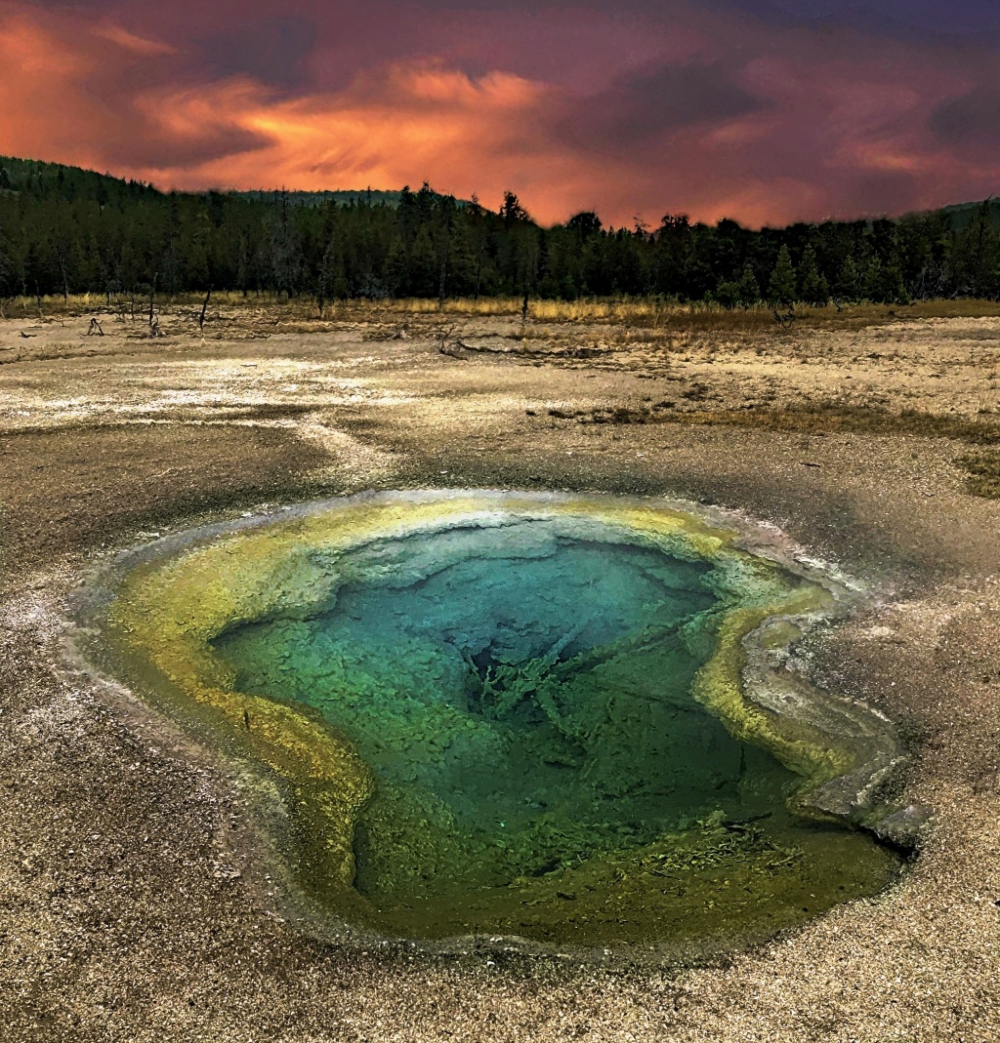Category: Nature Photography
Post Type:
Mixed Media
Photography
Mixed Media: Some | Enhanced sky and hot pool colors. Smart Photo Editor effects. Photoshop clouds for dramatic effect
Pays
one point
and 2 member cents.





© Copyright 2024. iPhone7 All rights reserved.
iPhone7 has granted FanStory.com, its affiliates and its syndicates non-exclusive rights to display this work.
Posted: June 14, 2020
      |
Thermal Hot Pool
Drama of Midway Geyser basin
by iPhone7
Interested in this? Contact The Artist
Nature Photo Contest Contest Entry
The Hot Springs of Yellowstone Park.
Hiding out in the park's hot springs, where temperatures are high enough to blister your skin and as acidic as liquid in a car battery, are heat-loving microbes known as thermophiles. And they're thriving. Where you see rings of color, there are, most of the time, rings of different bacteria, each group adapted to the conditions, such as temperature and Ph (how acidic a solution is) of their environments.
Aquamarine to dark blue
Typically the center of the hot spring is a brilliant aquamarine which is just above its underground water source, and it's where temperatures are the highest, up to 189 degrees Fahrenheit (or 87 degrees Celsius). There, the water is too hot for most microbial growth. It is, therefore, mostly clear water. The center of the spring is blue for the same reason that the sky is blue: When sunlight hits the water's surface, the light scatters, and blue light scatters the most, meaning that's what reflects back to your eyes.
The hot spring's water cools as it spreads farther from the source, and that, in turn, changes the bacteria that can live in it.
Yellow
Moving outward from the blue center, the first ring of color is yellow, thanks to cyanobacteria called Synechococcus. The temperature of this yellow band is about 165 degrees F (74 degrees C). Under other conditions, these bacteria might create a blue-green hue thanks to chlorophyll, a green pigment they produce that allows them to photosynthesize, or build carbohydrates and oxygen gas out of water, carbon dioxide, and energy from the sun, during the day. At night, they switch to another mode of energy production, fermentation. Often the sunlight hitting the spring is so intense that the bacteria produce another kind of pigment called carotenoids, which act as sunscreen for the bacteria. Carotenoids, which are also found in carrots, are orange and thus turn the normally green Synechococcus bacteria a more jaundiced shade.
Orange
In the orange band, which is a cooler 149 degrees F (65 degrees C), you'd find not only Synechococcus bacteria but also Chloroflexus bacteria, which also contain both chlorophyll, for photosynthesis, and the carrot-colored carotenoids.
Red-brown to burgundy
As you get farther from the center of the hot spring, the temperatures get lower and there is a greater diversity of microbes that can survive there. The spring's outermost layer, at 131 degrees Fahrenheit (55 degrees Celsius), is a red-brown or burgundy color. Another carotenoid-carrying microbe also comes into play at this temperature: Deinococcus-Thermus Thermus creates bright red or orange streamers. The Lower Geyser basin in Yellowstone has a reddish hue due to this bacteria.
by iPhone7 Interested in this? Contact The Artist
Hiding out in the park's hot springs, where temperatures are high enough to blister your skin and as acidic as liquid in a car battery, are heat-loving microbes known as thermophiles. And they're thriving. Where you see rings of color, there are, most of the time, rings of different bacteria, each group adapted to the conditions, such as temperature and Ph (how acidic a solution is) of their environments.
Aquamarine to dark blue
Typically the center of the hot spring is a brilliant aquamarine which is just above its underground water source, and it's where temperatures are the highest, up to 189 degrees Fahrenheit (or 87 degrees Celsius). There, the water is too hot for most microbial growth. It is, therefore, mostly clear water. The center of the spring is blue for the same reason that the sky is blue: When sunlight hits the water's surface, the light scatters, and blue light scatters the most, meaning that's what reflects back to your eyes.
The hot spring's water cools as it spreads farther from the source, and that, in turn, changes the bacteria that can live in it.
Yellow
Moving outward from the blue center, the first ring of color is yellow, thanks to cyanobacteria called Synechococcus. The temperature of this yellow band is about 165 degrees F (74 degrees C). Under other conditions, these bacteria might create a blue-green hue thanks to chlorophyll, a green pigment they produce that allows them to photosynthesize, or build carbohydrates and oxygen gas out of water, carbon dioxide, and energy from the sun, during the day. At night, they switch to another mode of energy production, fermentation. Often the sunlight hitting the spring is so intense that the bacteria produce another kind of pigment called carotenoids, which act as sunscreen for the bacteria. Carotenoids, which are also found in carrots, are orange and thus turn the normally green Synechococcus bacteria a more jaundiced shade.
Orange
In the orange band, which is a cooler 149 degrees F (65 degrees C), you'd find not only Synechococcus bacteria but also Chloroflexus bacteria, which also contain both chlorophyll, for photosynthesis, and the carrot-colored carotenoids.
Red-brown to burgundy
As you get farther from the center of the hot spring, the temperatures get lower and there is a greater diversity of microbes that can survive there. The spring's outermost layer, at 131 degrees Fahrenheit (55 degrees Celsius), is a red-brown or burgundy color. Another carotenoid-carrying microbe also comes into play at this temperature: Deinococcus-Thermus Thermus creates bright red or orange streamers. The Lower Geyser basin in Yellowstone has a reddish hue due to this bacteria.
Mixed Media: Some | Enhanced sky and hot pool colors. Smart Photo Editor effects. Photoshop clouds for dramatic effect
 Recognized |


Drama of Midway Geyser basin
by iPhone7

You need to login or register to write reviews. It's quick! We only ask four questions to new members.
© Copyright 2024. iPhone7 All rights reserved.
iPhone7 has granted FanStory.com, its affiliates and its syndicates non-exclusive rights to display this work.

